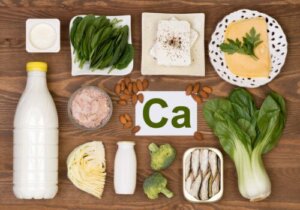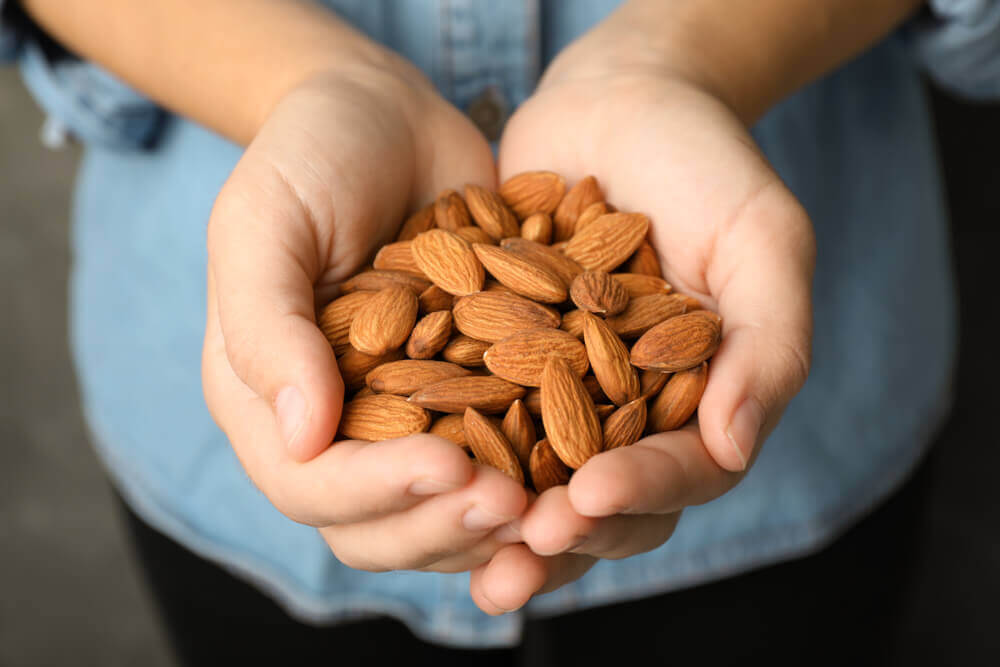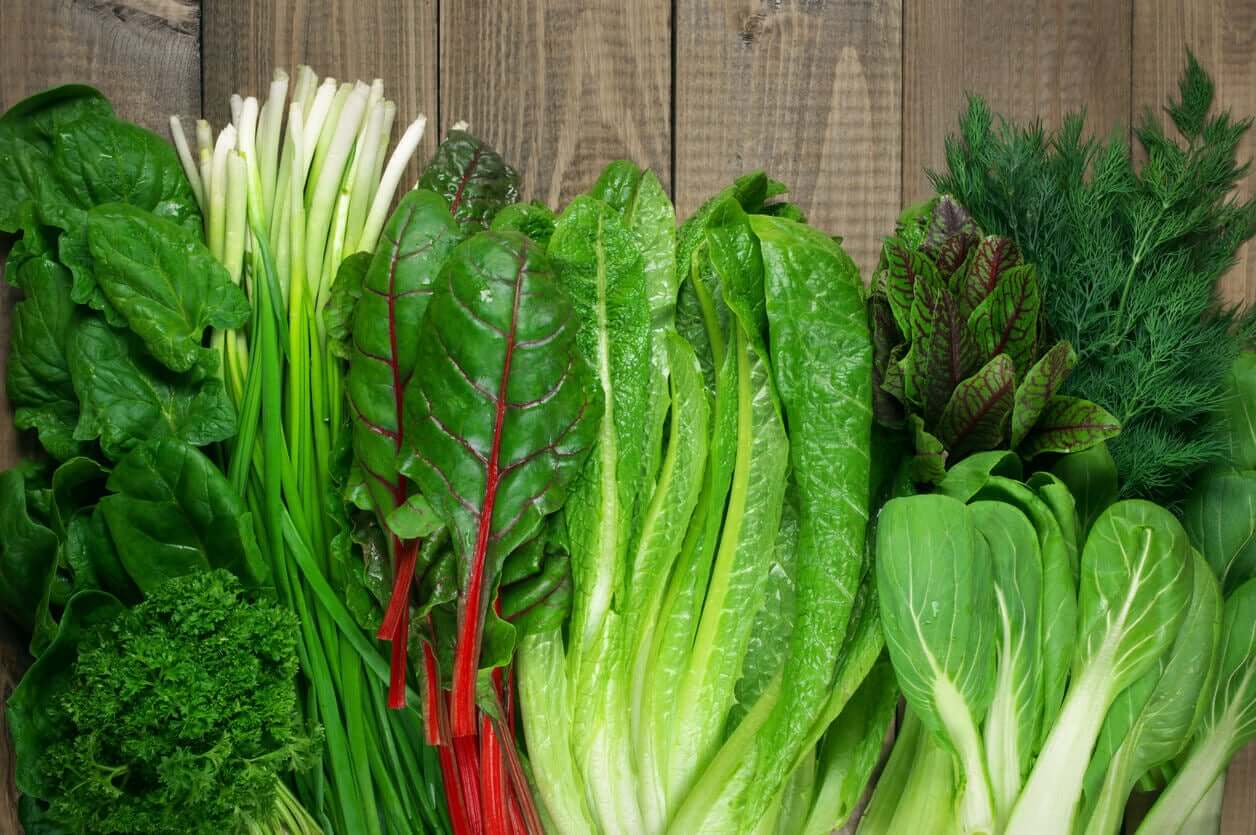The 25 Best High-Calcium Foods

Calcium is a fundamental mineral for children and adults. It ensures bone health and prevents the development of structural diseases, such as osteoporosis. In addition, this nutrient performs other important functions within human physiology. What’s clear is that meeting the daily calcium requirements becomes decisive during all stages of life. For this reason, we’re going to show you which are the best high-calcium foods so you can avoid a deficit that can condition the functionality of the body. Take note!
What’s the recommended daily amount of calcium?
Before starting to talk about the best high-calcium foods, it’s important to note that the recommended daily amount of calcium varies over the years.
Before the first year of life, it’s 260 milligrams, but from there to three years of age, it almost triples.
From childhood, the requirements are around one gram per day, but they increase during pregnancy or while breastfeeding lasts.
However, it’s important to bear in mind that for calcium to be used optimally, it’s essential to also have adequate levels of vitamin D, according to research published in Frontiers of Hormone Research. This vitamin allows a proper fixation of the mineral inside the bones.
At the same time, it’s essential to ensure the practice of physical exercise on a regular basis so that the bone tissue remains strong over time. According to a study published in the Brazilian Journal of Physical Therapy, keeping muscles in good condition protects bones from fractures.
The best high-calcium foods
Next, we’re going to tell you which are the best high-calcium foods that you can include in your diet. Keep in mind that to take advantage of their qualities to the fullest, they must be included in the context of a balanced and varied diet.
1. Cheese
Cheese provides 800 milligrams of the nutrient for every 100 grams of product. However, its consumption must be carried out with certain precautions in the case of risk groups, as it may contain Listeria inside. To avoid this problem, it’s always recommended to consume those made with pasteurized milk.
2. Milk
Milk is a drink that also provides a good amount of calcium, at a rate of 300 milligrams per glass. In addition, it contains vitamin D, which is why the fixation of the mineral in the bones is stimulated. It’s recommended during all stages of life.
3. Yogurts
Yogurts not only provide calcium, but also concentrate probiotics inside. These elements improve the functioning of the intestinal microbiota and allow an efficient metabolism.
4. Sardines
Sardines are a source of calcium, especially when they’re consumed canned because the bones are used. In this context, they’re capable of providing about 340 milligrams of the mineral per 100 grams, in addition to a good dose of omega 3.
5. Shrimp
Shellfish are nutritionally dense foods. As far as calcium is concerned, they have 220 milligrams per 100 grams of product, a not inconsiderable contribution. Their inclusion in the diet could help prevent the development of osteoporosis.
6. Figs
Many of the dried fruits are a source of calcium. Now, it’s important to remember that they also have added sugars inside. For this reason, their intake must be controlled to avoid alterations in metabolic health.
7. Dried tomatoes
Tomatoes are one of the most beneficial fruits for the body, due to their concentration of phytochemicals. They also provide a significant dose of calcium, around 110 milligrams per 100 grams of food.
8. Almonds

The consumption of nuts is totally recommended to avoid nutritional deficiencies that can condition the state of health. Almonds are the fruits that contain the most calcium, with a contribution of 260 milligrams per 100 grams of food.
9. Hazelnuts
Another of the best nuts is hazelnut. These nuts contain 230 milligrams of calcium for every 100 grams of food and have a significant dose of protein inside them. This also helps maintain muscle health.
10. Pistachios
Their calcium content is lower than in the two previous cases, with a contribution of 136 milligrams per 100 grams of product. However, they’re a source of vitamin E, a powerful antioxidant that protects against the development of complex diseases.
11. Sesame seeds
Seeds are in vogue and can be included in your diet to increase the nutritional density of meals. Sesame seeds, in particular, provide 975 milligrams of calcium per 100 grams. Therefore, in many cases, the recommended daily amount is covered.
12. Poppy seeds
If you want to ensure optimal calcium intake, include poppy seeds in your diet. With a concentration of 1460 milligrams per 100 grams of product, they’re among the richest foods in the mineral. Of course, they’re quite energetic.
13. Fennel seeds
Fennel seeds are another good option to prevent osteoporosis, with 1,300 milligrams of calcium per 100 grams of food. They can be included in salads and breads with ease.
14. Chia seeds
Perfect to include in breakfasts combined with dairy products. Chia seeds provide 630 milligrams of calcium per 100 grams, which establishes them as one of the foods with the highest concentration of the nutrient.
15. Dill
Herbs can be a source of micronutrients and phytochemicals. For this reason, it’s good to include them in the diet as garnishes. Dill, for example, has 1700 milligrams of calcium for every 100 grams of product.
16. Oregano
Another option to prevent osteoporosis is oregano. It has 1500 milligrams per 100 grams, an excellent contribution as long as the levels of vitamin D in the body are within optimal ranges.
17. Wakame seaweed
Algae are foods that are very popular right now. They’re introduced into the diet from oriental influences and stand out for their concentration in micronutrients. In the case of calcium, wakame provides 660 milligrams per 100.
18. Nori seaweed
Nori seaweed is the most common when preparing sushi, an energetic but nutritious dish. It has 430 milligrams of calcium inside it for every 100 grams of food, a not inconsiderable concentration.
19. Chickpeas
Legumes are a source of nutrients. However, their fiber content can negatively modulate its absorption. Specifically, chickpeas provide 145 milligrams of calcium per 100.
20. Beans
Beans are also a source of calcium. Every 100 grams of product contains 150 milligrams of the mineral. However, pintos are those that concentrate the greatest amount, and green beans are those that contribute the least.
21. Watercress
It’s essential to include green leafy vegetables in the diet. Watercress, for example, has 220 milligrams of calcium per 100 grams of food, which makes them a perfect complement to salads.
22. Kale
Surely you’ve heard of the benefits of crucifers. They not only stand out for the presence of phytochemicals inside, but also for their contribution of calcium. They have 200 milligrams of the nutrient for every 100 of the product.
23. Broccoli
Broccoli is another cruciferous vegetable that’s loaded with positive health effects. It’s good for preventing osteoporosis, with a content of 60 milligrams of calcium per 100 of food.
24. Spinach
Spinach is a source not only of iron but of calcium as well. It’s good to include it in your diet on a regular basis to avoid health problems caused by nutritional deficits. It can be eaten raw or cooked.

25. Swiss chard
Finally, we’re going to talk to you about chard. This leafy green provides 105 milligrams of calcium per 100 grams of product and you can prepare it in stews or in broth to take better advantage of all its nutrients.
Include high-calcium foods in your diet
As you’ve seen, calcium is an important mineral to ensure the good health of bone tissue. It’s essential that it appear in your daily schedule in sufficient quantities. Otherwise, you could experience problems in the medium and long term.
Keep in mind that to prevent osteoporosis, it’s also essential to increase the practice of physical exercise and get frequent sun exposure. Therefore, the synthesis of vitamin D through the skin is stimulated.
Calcium is a fundamental mineral for children and adults. It ensures bone health and prevents the development of structural diseases, such as osteoporosis. In addition, this nutrient performs other important functions within human physiology. What’s clear is that meeting the daily calcium requirements becomes decisive during all stages of life. For this reason, we’re going to show you which are the best high-calcium foods so you can avoid a deficit that can condition the functionality of the body. Take note!
What’s the recommended daily amount of calcium?
Before starting to talk about the best high-calcium foods, it’s important to note that the recommended daily amount of calcium varies over the years.
Before the first year of life, it’s 260 milligrams, but from there to three years of age, it almost triples.
From childhood, the requirements are around one gram per day, but they increase during pregnancy or while breastfeeding lasts.
However, it’s important to bear in mind that for calcium to be used optimally, it’s essential to also have adequate levels of vitamin D, according to research published in Frontiers of Hormone Research. This vitamin allows a proper fixation of the mineral inside the bones.
At the same time, it’s essential to ensure the practice of physical exercise on a regular basis so that the bone tissue remains strong over time. According to a study published in the Brazilian Journal of Physical Therapy, keeping muscles in good condition protects bones from fractures.
The best high-calcium foods
Next, we’re going to tell you which are the best high-calcium foods that you can include in your diet. Keep in mind that to take advantage of their qualities to the fullest, they must be included in the context of a balanced and varied diet.
1. Cheese
Cheese provides 800 milligrams of the nutrient for every 100 grams of product. However, its consumption must be carried out with certain precautions in the case of risk groups, as it may contain Listeria inside. To avoid this problem, it’s always recommended to consume those made with pasteurized milk.
2. Milk
Milk is a drink that also provides a good amount of calcium, at a rate of 300 milligrams per glass. In addition, it contains vitamin D, which is why the fixation of the mineral in the bones is stimulated. It’s recommended during all stages of life.
3. Yogurts
Yogurts not only provide calcium, but also concentrate probiotics inside. These elements improve the functioning of the intestinal microbiota and allow an efficient metabolism.
4. Sardines
Sardines are a source of calcium, especially when they’re consumed canned because the bones are used. In this context, they’re capable of providing about 340 milligrams of the mineral per 100 grams, in addition to a good dose of omega 3.
5. Shrimp
Shellfish are nutritionally dense foods. As far as calcium is concerned, they have 220 milligrams per 100 grams of product, a not inconsiderable contribution. Their inclusion in the diet could help prevent the development of osteoporosis.
6. Figs
Many of the dried fruits are a source of calcium. Now, it’s important to remember that they also have added sugars inside. For this reason, their intake must be controlled to avoid alterations in metabolic health.
7. Dried tomatoes
Tomatoes are one of the most beneficial fruits for the body, due to their concentration of phytochemicals. They also provide a significant dose of calcium, around 110 milligrams per 100 grams of food.
8. Almonds

The consumption of nuts is totally recommended to avoid nutritional deficiencies that can condition the state of health. Almonds are the fruits that contain the most calcium, with a contribution of 260 milligrams per 100 grams of food.
9. Hazelnuts
Another of the best nuts is hazelnut. These nuts contain 230 milligrams of calcium for every 100 grams of food and have a significant dose of protein inside them. This also helps maintain muscle health.
10. Pistachios
Their calcium content is lower than in the two previous cases, with a contribution of 136 milligrams per 100 grams of product. However, they’re a source of vitamin E, a powerful antioxidant that protects against the development of complex diseases.
11. Sesame seeds
Seeds are in vogue and can be included in your diet to increase the nutritional density of meals. Sesame seeds, in particular, provide 975 milligrams of calcium per 100 grams. Therefore, in many cases, the recommended daily amount is covered.
12. Poppy seeds
If you want to ensure optimal calcium intake, include poppy seeds in your diet. With a concentration of 1460 milligrams per 100 grams of product, they’re among the richest foods in the mineral. Of course, they’re quite energetic.
13. Fennel seeds
Fennel seeds are another good option to prevent osteoporosis, with 1,300 milligrams of calcium per 100 grams of food. They can be included in salads and breads with ease.
14. Chia seeds
Perfect to include in breakfasts combined with dairy products. Chia seeds provide 630 milligrams of calcium per 100 grams, which establishes them as one of the foods with the highest concentration of the nutrient.
15. Dill
Herbs can be a source of micronutrients and phytochemicals. For this reason, it’s good to include them in the diet as garnishes. Dill, for example, has 1700 milligrams of calcium for every 100 grams of product.
16. Oregano
Another option to prevent osteoporosis is oregano. It has 1500 milligrams per 100 grams, an excellent contribution as long as the levels of vitamin D in the body are within optimal ranges.
17. Wakame seaweed
Algae are foods that are very popular right now. They’re introduced into the diet from oriental influences and stand out for their concentration in micronutrients. In the case of calcium, wakame provides 660 milligrams per 100.
18. Nori seaweed
Nori seaweed is the most common when preparing sushi, an energetic but nutritious dish. It has 430 milligrams of calcium inside it for every 100 grams of food, a not inconsiderable concentration.
19. Chickpeas
Legumes are a source of nutrients. However, their fiber content can negatively modulate its absorption. Specifically, chickpeas provide 145 milligrams of calcium per 100.
20. Beans
Beans are also a source of calcium. Every 100 grams of product contains 150 milligrams of the mineral. However, pintos are those that concentrate the greatest amount, and green beans are those that contribute the least.
21. Watercress
It’s essential to include green leafy vegetables in the diet. Watercress, for example, has 220 milligrams of calcium per 100 grams of food, which makes them a perfect complement to salads.
22. Kale
Surely you’ve heard of the benefits of crucifers. They not only stand out for the presence of phytochemicals inside, but also for their contribution of calcium. They have 200 milligrams of the nutrient for every 100 of the product.
23. Broccoli
Broccoli is another cruciferous vegetable that’s loaded with positive health effects. It’s good for preventing osteoporosis, with a content of 60 milligrams of calcium per 100 of food.
24. Spinach
Spinach is a source not only of iron but of calcium as well. It’s good to include it in your diet on a regular basis to avoid health problems caused by nutritional deficits. It can be eaten raw or cooked.

25. Swiss chard
Finally, we’re going to talk to you about chard. This leafy green provides 105 milligrams of calcium per 100 grams of product and you can prepare it in stews or in broth to take better advantage of all its nutrients.
Include high-calcium foods in your diet
As you’ve seen, calcium is an important mineral to ensure the good health of bone tissue. It’s essential that it appear in your daily schedule in sufficient quantities. Otherwise, you could experience problems in the medium and long term.
Keep in mind that to prevent osteoporosis, it’s also essential to increase the practice of physical exercise and get frequent sun exposure. Therefore, the synthesis of vitamin D through the skin is stimulated.
All cited sources were thoroughly reviewed by our team to ensure their quality, reliability, currency, and validity. The bibliography of this article was considered reliable and of academic or scientific accuracy.
- Agencia Española de Seguridad Alimentaria y Nutrición. (25 de mayo de 2023). Recomendaciones de consumo de pescado por presencia de mercurio. https://www.aesan.gob.es/AECOSAN/web/seguridad_alimentaria/ampliacion/mercurio.htm
- Harvard T. H. Chan School of Public Health. (2023). Calcium. The Nutrition Source. https://www.hsph.harvard.edu/nutritionsource/calcium/
- International Osteoporosis Foundation. (s.f.). Calcium. https://www.osteoporosis.foundation/health-professionals/prevention/nutrition/calcium
- Mayo Clinic. (1 de noviembre de 2022). Calcio y suplementos de calcio: lograr el equilibrio adecuado. https://www.mayoclinic.org/es/healthy-lifestyle/nutrition-and-healthy-eating/in-depth/calcium-supplements/art-20047097
- Müller, A. K., Helms, U., Rohrer, C., Möhler, M., Hellwig, F., Glei, M., Schwerdtle, T., Lorkowski, S., & Dawczynski, C. (2020). Nutrient Composition of Different Hazelnut Cultivars Grown in Germany. Foods, 9(11), 1-11. https://pubmed.ncbi.nlm.nih.gov/33153116/
- National Institutes of Health. (19 de septiembre de 2023). Calcio. https://ods.od.nih.gov/factsheets/Calcium-DatosEnEspanol/
- U.S. Department of Agriculture. (1 de abril de 2019). Seeds, sesame seeds, whole, dried. FoodData Central Research Results. https://fdc.nal.usda.gov/fdc-app.html#/food-details/170150/nutrients
- U.S. Department of Agriculture. (1 de abril de 2019). Seeds, chia seeds, dried. FoodData Central Research Results. https://fdc.nal.usda.gov/fdc-app.html#/food-details/170554/nutrients
- U.S. Department of Agriculture. (1 de abril de 2019). Cheese, mozzarella, whole milk. FoodData Central Research Results. https://fdc.nal.usda.gov/fdc-app.html#/food-details/170845/nutrients
- U.S. Department of Agriculture. (28 de octubre de 2022). Fish, sardines, canned. FoodData Central Research Results. https://fdc.nal.usda.gov/fdc-app.html#/food-details/2341708/nutrients
- U.S. Department of Agriculture. (1 de abril de 2019). Nuts, almonds. FoodData Central Research Results. https://fdc.nal.usda.gov/fdc-app.html#/food-details/170567/nutrients
- U.S. Department of Agriculture. (1 de abril de 2019). Figs, dried, uncooked. FoodData Central Research Results. https://fdc.nal.usda.gov/fdc-app.html#/food-details/174665/nutrients
This text is provided for informational purposes only and does not replace consultation with a professional. If in doubt, consult your specialist.








